Pegaso (ENASA) BMR 600
 Ejército de Tierra de España
Ejército de Tierra de España Armored Personal Carrier, c1515 built* (1979-1988).
The main Spanish wheeled AFV

The Pegaso 3560 BMR was for decades, and still is today for a few more years, the main wheeled Spanish main armoured fighting vehicle, related to the Swiss Mowag Piranha and Austrian Pandur I. It was built by the only Spanish industrial heavyweight capable of undertaking this project, Pegaso. The BMR for "Blindado Medio sobre Ruedas", was a modular 6x6 armoured personal carrier (APC) declined into multiple variants, produced from 1979 and exported to six countries. It was seconded by the VEC Infantry Fighting Vehicle (IFV) based on the same chassis. *Production is the total of Spanish-built vehicles, exports, and locally-built Saudi Vehicles plus prototypes.
Initial development
The late 1960s for Spain was that of intense modernization. Through MDAP from the Madrid Pact of 1953, the country has been equipped with US equipments, the M24 Chafee, then M41 Walker Bulldog, M47 Patton and M48 Patton II Tanks, M37 105 mm HMC then M107 and M109 self-propelled guns. The Ifni war was fought with M8 ‘Hércules’ (Greyhound) wheeled vehicles, and Jeeps mostly, showing the need for faster wheeled APCs. Also M4A1s half tracks were delivered, M16 SPAAGs. Withing the Spanish Economic Miracle, it was possible to see Pegaso (Later integrated into ENASA) as a base to develop local armoured vehicles, as the company already started production of domestic military trucks. Until they were the only way to carry troops to the front, but were soft-skinned.With industrial consolidation, two entities were created, Material y Construcciones S.A. (MACOSA) and Internacional de Comercio y Tránsito S.A. (INCOTSA) partnered to propose tro the Army a serie of national-produced armored vehicles for the troop transportation request by the Army. First with the ambitious tracked VBCI-1E General Yagüe, the "Spanish M113". It looked the part, had a very similar hull and drivetrain and was powered by a 352 hp Pegaso 9156/8 engine. Inspired also by the M114 and also worked on a Spanish equivalent, the VBCC-1E General Monasterio. But nothing came of both vehicles. They failed to meet requirements. With further aid from the US in the 1960-70s came the M113 tracked armored personal carrier, which was adopted en masse from 1964. The latter was known locally as "TOA", acronym for "Transporte Oruga Acorazado" (Armored Tracked Carrier). In all, 453 were delivered and they constituted the bulk of Spanish armored personal carrier force.
However it was recoignized before this that a wheeled vehicle would be easier to manufactured than a tracked one, and the same consortiums partnered on a more modest project, which gained traction. At the end of the 1960s, INCOTSA proposed the 4x4 APC VBTT-E4. Not only all components were produced nationally but it could carry 10 soldiers, had a turret with a 40 mm grenade launcher, MG-42 machine gun. More variants were made. But this project again never reached production stage. So afterwards, US deliveries answered Spanish needs. But the idea of developing a domestic armored vehicle was still in the works.
In 1972, the Spanish Army set tactical and technical requirements for the development of a wheeled armoured vehicle tasked of carrying an infantry platoon within the combat zone. Designed by the Commission for the Development of Armed Vehicles, the Army and ENASA's (Pegaso group) project management, the BMR-600 prototype was evaluated for four years. It was originally powered by a Pegaso 9157/8 306 hp diesel engine with automatic gearbox, torque converter, independent suspension on all six wheels, plus amphibious capability with two hydrojets, and air-transportable. This based notably looked at the previous VBTT-E4, with one more axle and extra modifications, notably looking at the Piranha 6x6. Other specs on the development still not have been released.
Production of the BMR

Old and new batches of the BRM-600 (3560.51 and 50) showing the differences (TE, src ).
Production started in 1979 officially, but with a preserie to be tested on a first active unit, and further modifications made in 1980-81. In 1982 at last, ENASA presented two prototypes for a BMR company and battalion command vehicle with a reworked interior, to be produced as the BMR-600 and 600PC under the internal designation ENASA 3560.51. The Standardized version appeared in 1984 and production was ramped up while export proposals were underway (see later). In 1984-1986 a new batch of 173 BMR-600s (or BMR 3560.50) intended for export to Egypt but adopted by the Ejercito. Differences were cosmetic between ergonomics improvements (from batallion reports) and a more powerful engine for the later batch. These were called the "second series" and went to Egypt and Saudi Arabia.
The first variant was soon unveiled, the ENASA 3560.54 (Ambulance, also called BMR AMB) of which eight were adopted by the Ejercito in their original state, sharing the same hull, with enough space for four stretchers only. Photo. A latter specialized version had the new raised hull, enabling two more stretchers, but also enabling more variants to be built, like the Command one, and EDEX for ordnance disposal later. Grand total is circa 1,515 counting also the Saudi vehicles and prototypes. Spain alone built c1,213 vehicles.
BMR and Pandur

The two vehicles as often compared, for good reasons: Although it was developed alone by the Austrian company Steyr-Daimler-Puch Spezialfahrzeuge (SSF) in the 1980s, it had a very similar 6x6 chassis with relatively close dimensions, shapes and weight, armed the same way. The hull however had a raised back, and finer sloped armour. It also appeared later in production, and arrived in service a decade later in 1996. It was exported to six countries included the USA and later modernized by GD ELS, parent company of both MOWAG and Santa Bárbara Sistemas, hence a further connection down the line. There were similar parts in the modernization of the Pegaso BMR M1 (BRM 2 program) as well. Austria and Spain would fully collaborate on a fully tracked IFV, the ASCOD Pizarro/Uhlan as well through Santa Barbara Sistermas. Both the Pandur II and BMR M1 shared components.
Detailed Design
General Configuration
The Pegaso BMR is distinct from the contemporary MOWAG 6x6 Piranha in that it lacked the beak of the latter and instead went to maximize internal space, by having a less sloped forward nose, and with a two-tiered upper plate catacteristic of the vehicle. The vehicle weights 15,4 t in battle order for 6,15 m in lenght, 2,50 m in width and 2,76 m in height. The hull is made of reinforced Aluminum armor (same type as used on the M113), 10 mm on the sides, back and roof, 40 mm for the nose, protecting from small arms fire and artillery shell splinters. It is estimated immune to heavy machine gun fire (13-14.5 mm) on the nose and small arms/splinters all around. There is also a collective NBC protection system, and the active protection is completed by two rows of six electrically-discharged smoke dischargers on either side forward. They are angled differently to better cover the vehicle's surroundings when activated.The BMR-600 is a classic wheeled APC, and as the Wowag, it has the whole power unit located to the right, and the driver and commander located in tandem on the right. The driver is seated behind the upper sloped plate of the nose, and see through two small side windows and a larger one forward, protecting by a large folding panel in which is located a smaller armoured window. Their shape and fixation is different (as many other details) on the S1 and S2 (see later). The commander is seated behind the driver in an elevated position inside a peripheric vision cupola. He has height vision blocks all around, with the forward one swappable for an infrared block. The driver has no such system. The main weapon system is installed on top of the cupola.
Aft of the engine and driver-commander's position is located the troop compartment, not separated from the commander, which can house 11 seated infantrymen, including five on inwards facing bunks (so no fire on the move through pistol ports possible). Troops can enter and leave the vehicle through the rear ramp doors, but also two large roof hatches. The forward hatch can be surrounded by extra vertical panels to protect men firing on the move while standing inside; The panels comes with slits apertures. These is also a single firing port from each side.
The serie I is recoignisable to the forward square side window and its cover down, modified front window and shutter panel, modified lights/blackout light guard and other details along the hull. The cupola is stlightly lower and the HMG gun mount different. Attachement points to the steel cable making for a more compact storage, there are two "pistol" ports with opening firing shutters on either side, and attachements for half-mast allowing winch up the engine from its compartment, and at the upper section, attachmenets points for two jerrycans. Optionally it has fixtures to attach extra tooling boxes on the sides, attachments for the right side pannier, and another removable aft for extra storage.
The Serie II had simpler, no cover, rectangular side windows forward, single window on the side, different steel cable attachment points, straps and a set of digging tools (shovel, pickaxe, axe, crowbar and others) in a box aft instead of the jerrycans (it is located on the right side fowards on S1). The cupola is slightly modified and taller, the gun mount now completely encases the remotelly operated HMG.
Powerplant and Performances

The BMR-600 is powered by the Scania DS9 61A MIL Pegaso 9157/8, 6 cylinders 9l turbodiesel engine rated for 306 hp. It is located in the left compartment (seen from behind), with its main exhaust in a silencer/thermal dispenser, running along the upper hull. In front of the engine in the section of the nose protected by two sloped plates, is located the German-provided (licence-built by Pegaso/Enasa) ZF model 6HP500 transmission with automatic gearbox and torque converter. It can be accessed from the large forward hatch (as well as the engine) of the upper part of the nose plate, which is straight unlike the right side, on which the plate has a break. Below this large service hatch is located another access hatch, which can receive an optional winch. The main engine unit can be access through the flat roof section's louvres panels above.
The BMR-600 is fitted with hydropneumatic suspension for all three roadwheels on either side, with adjustable ground clearance. The drivetrain comprises three large fully directional roadhweels per side with run-flat tyres type. A central inflation system is installed. The BMR-600 APC is fully amphibious and propelled by two waterjets, which are optional. If installed, the aftermost hull panels are removed to install the tubular propellers, capable of directional traverse. They are activated through two sub-shafts coming from the engine compartment. In addition, an optional composed trim vane can be installed on the nose beak. All amhibious versions also have a more powerful bilge pump.
Performances-wise, the Pegaso BMR had a power-to-weight ratio of 20,12 hp/ton and a top speed on road of 90 km/h, and circa 40-60 kph off-road epending of the conditions. For range it has a main fuel tank carrying 400 liters, for 1000 km nominal, more with the extra jerrycans. When swimming without preparation, the roadhweels provides some motricity and direction, and the vehicle is fully amphibious without preparations. However the specific amphibious versions has the rear propellers, extra trim vane forwards, better bilge pump among others. It can swim at 10 kph. It can also climb a 60% slope, stay stable on a side slope of 30%, climb a vertical step of 0.6 m and gap a trench of 1.20 m. It is not protected against IEDs and Mines but the 6x6 drive allows the vehicle to loose a roadwheel and still make it up back to base.
Armament
The basic BMR-600 is armed with a cupola-mounted bipod M2HB Browning heavy machine gun, the famous, trusted, venerable "ma deuce" shared by all NATO countries. The 12,70 mm 90 caliber had a main ammunition belt and reloads for up to 2500 ammunition projectiles, including AP and tracers. The bipod is specific, partially encasing the gun and enabling its operation from below. Thanks to the high position, it has a significant recess and the vehicle can fire from a hull down position. It has also a good elevation up to 90° to shoot helicopters. The mount itself has periscopes on its sides and forward. But the rear part of the mount can be removed and the HMG manned from an operator seated on the roof as well. The mount was improved on the M1 variant.Through its numerous derivatives, the BMR-600 had been tested for export with a large variety of ordnances:
-ECIA L-65/81 81mm and ECIA L-65/120 120mm NATO mortars: Installed in the rear of the compartment, firing from the rear roof hatch
-Antitank missiles (ATGM) MILAN (a few), TOW (the majority) and HOT -prototype only). The launcher is located from a position in between the two roof hatches. To avoid interference, the 12.7mm mount is removed from the cupola. Extra tubes are stored on the roof front-left, after the engine louvres, and extra missiles are carried inside and reload done from the rear hatch.
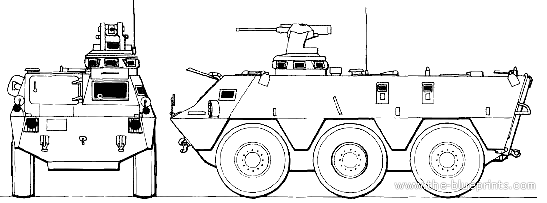
BMR-600 specifications | |
| Dimensions | 6,15 x 2,50 x 2,76 m |
| Total weight, battle ready | 15,4 t |
| Crew | 2+8 (driver, commander, 8 infantry) |
| Propulsion | Pegaso 9157/8 310 hp diesel |
| Suspension | Hydraulic dampers |
| Speed (road) | 90 km/h (55 mph) |
| Armament | M2HB 12.7 mm RWS |
| Armor | 10-40mm hardened aluminium |
| Total production | c1500+ |
The BMR 2 program & Evolution
BRM M1

BRM M1 in Afghanistan. The add-on bolted plates are quite obvious in this angle. Note the add-on side protection panels also, allowing the crew to keep the roof hatches open. On is manning directly the HMG.
In the late 1990s it was obvious the BMR-600 needed improvements, and this led to the M2 program, started from 2004. The BMR M1 armored personnel carrier saw the replacement for the original 310 CV Pegaso engine with a Scania 306, much lighter, with greater specific power and greater supercharging. Additional armor based on add-on bolted steel plates, improved bacteriological and chemical defense protection, new fuel source system, height adjustable steering wheel, automatic anti-fire and anti-explosion exinguishers, self-ventilating brakes, new heating and air conditioning, centralization in quick plugs of all electrical connections, new configuration of the troop compartment and update of the turret to the TC-3A1.5 standard. Over 600, so the whole serviceable fleet was upgraded to this standard up to recently. The upgrade package also has been proposed to the vehicle's customers.
Planned replacement
Further down the line in the 2010s, ageing and having an obsolete protection against IEDs and modern ATGMs, the Spanish MoD decided to upgrade the BMR fleet with the "Dragon program". It is comprising a brand new new 8×8 vehicle (VCR) with the acquisition in first phase of 240 vehicles, divided into three variant, the basic APC to replace part of the BMR M1 (113), a modern command post, with eight vehicles replacing the BMR M1 PC, and a third version for cavalry scouting, replacing the VEC M1 (119 vehicles concerned). At least 40 were due to be available before 2014, the rest before the end of 2016, but delays accumulated until 2022 when it was completed.The contract was rated initially to €1.3 billion, signed in June 2010. Santa Bárbara Sistemas partners on it with Iveco-Oto Melara (Italy), Krauss-Maffei-Wegmann (Germany), Nexter (France), Patria (Finland) and through the mother company of Santa Barbara, BAE Systems-Hägglunds (UK) and General Purpose Vehicles (US). Part of it was the acquisition of the MRAP RG-MK5E Nyala deployed in international peace keeping missions.
Variants, Exports and Service
Variants

ENASA BRM 3560.55 ARV. 8 for Spain, more to Egypt and Saudi Arabia.

ENASA BRM 3560.56 Transmission vehicle. 4 made named after deities: Mercurio, Centauro, Plutón, and Tritón (c16 total)

ENASA BRM 3560.01 HCT-2 prototype firing a TOW missile.

ENASA BRM-600 C/C MILAN ("Cazador de Carro") of which 32 were built.
- BMR 3560.50 (BMR-PP): Basic APC. 12.7mm Browning M2HB/LAF-40 grenade launcher in TC-3A1 2-seater turret.*
- BMR EDEX: Explosive Ordnance Disposal (EOD) vehicle: Raised rear, tailored equipment
- BMR C/C MILAN: Tank destroyer equipped with MILAN ATGM.
- BMR C/C TOW: Tank destroyer with BGM-71 TOW.
- BMR VCZ: Sapper Combat Vehicle (CEV), dozer blade, 7-ton cap. winch.
- BMR VRAC-NBQ: NBC reconnaissance vehicle.
- BMR GEL: Electronic Warfare version with special equipment in rear comp.
- BMR 3560.51 (BMR-PC): Command Post vehicle, with raised rear.
- BMR 3560.53E (BMR-PM-81): Mortar carrier vehicles with an ECIA L-65/81 81mm mortar.
- BMR 3560.54 (BMR AMB): Ambulance with raised rear, 6 stretchers.
- BMR 3560.55: ARV: Recovery and light repair vehicle with crane, winch and towbars.
- BMR 3560.56: Transmission vehicle.
- BMR 3560.57: Tank destroyer with HOT missiles (prototype).
- BMR 3560.59E: Also PM-120 Mortar Carrier with the ECIA L-65/120 120 mm.
- VMA Amphibious Mechanized Vehicle for Spanish Marine Infantry, prototype**
**Instead the Spanish Marines ordered the MOWAG Piranha IIIC.
Prototypes and derivatives

The boat-like second VMA prototype destined to the Navy. It was refused and the latter ordered eventually the AA7V.
In 1985 Spain also created the ENASA 3564.1/BMR-640 CV with a GIAT TS turret (90 mm gun) version for Egypt, never produced, in 1987 one with a TC-7 turret (2x 106 mm recoilless guns), or with a 25 mm autocannon from the VEC plus Spanish 5.56 mm machine gun in a new lightweight turret. To answer a Kenyan bid, one was also converted to carry the Sidam-25 turret, but went nowhere. In 1991 even a civilian variant was proposed, the Vehículo de Rescate de Áreas Catastróficas (VRAC), took over by Santa Barbara Sistemas, but went no further than the prototype also.
Probably the best and only variant became the VEC, still carrying troop but armed with a potent 20 mm Rh-202 autocannon in a TC-20 turret (4 prototypes) and then the TC 25 turret with the Bushmaster cannon. 96 VECs were also received H-90 turrets (from discarded AML-90s). Another tested a OTO Melara gun and another a Cockerill Mk III turret and a 90 mm gun. The VEC will be treated in a standalone article.
Also sharing many components with the standard BMR-600, ENASA also unveiled in 1979 the Blindado Ligero de Rueda (BLR) or ENASA 3540, a cheaper but internally larger 4x4 alternative destined to export. It was adopted by Spain and Ecuador: Guardia Civil 16 as ENASA 3540.01, 28 to the Spanish Navy, 14 to the Spanish Air Force as ENASA 3545.00 and 20 to Ecuador. Also to be treated in a standalone article.
Exports
 Spain: 682, between the Army
Spain: 682, between the Army Egypt 260 delivered from 1982, all for the Army.
Egypt 260 delivered from 1982, all for the Army. Mexico: 7 with the Mexican Marines, possibly not operated anymore.
Mexico: 7 with the Mexican Marines, possibly not operated anymore. Peru: 20 with the Peruvian Marines.
Peru: 20 with the Peruvian Marines. Saudi Arabia: 140 to the Navy in 1983, plus 300 locally produced. Saw action in Yemen.
Saudi Arabia: 140 to the Navy in 1983, plus 300 locally produced. Saw action in Yemen. Morocco: 100 (no details on these).
Morocco: 100 (no details on these).
Combat Service
The BMR already saw heavy combat action with Saudi Arabia (Yemen War since 2015 notably) and Egypt, during the Kuwait campaign in 1991, as well as by the Spanish Army. International deployments of the Spanish Army included Peacekeeping Operations in the former Yugoslavia (SFOR, KFOR, MINUK), Afghanistan (ISAF), operations in Iraq as part of the international coalition (Operation New Dawn) and in Lebanon (UNIFIL). The M1 is secheduled for replacement in the 2030s. So far none was sent to Ukraine but it is a possibility, as much as the new VCR Dragon is going operational.Illustrations
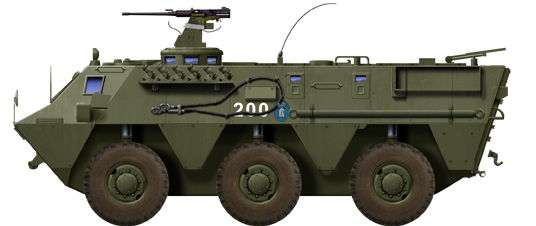
BMR 600 Serie 1, Academia de Caballeria 1985
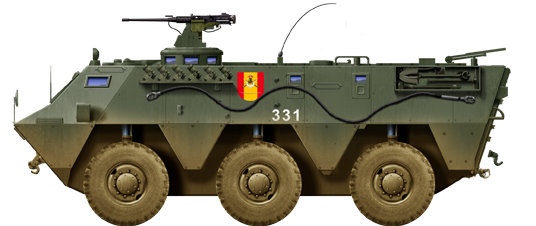
BRM 600 serie 1, unknown unit
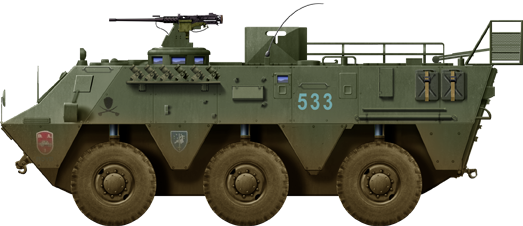
BRM 600 serie 1 (unknown unit) with full storage bins, extra shield up.
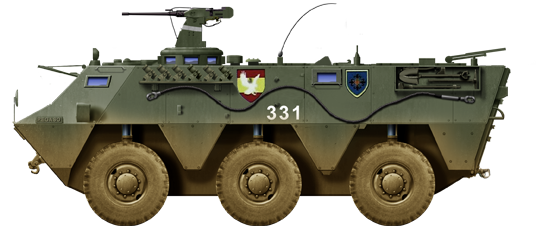
BRM 600 serie 2, Tetuan Rgt.

S2 BRIMZ "La Reina" Rgt. (Torre MOWAG, GOE)
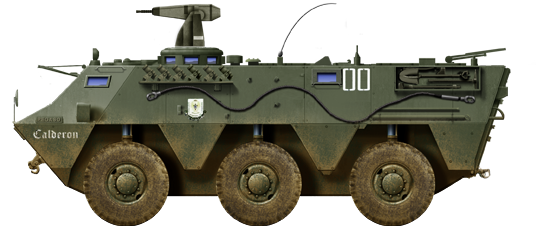
S2 Regiment Infantry Tenerife 1984

Egyptian S2 (modernized), Gulf War 1991

In UN color, KFOR, Bosnia 1995 (To come)
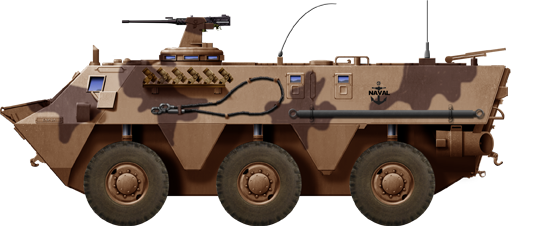
Peruvian Marines Vehicle
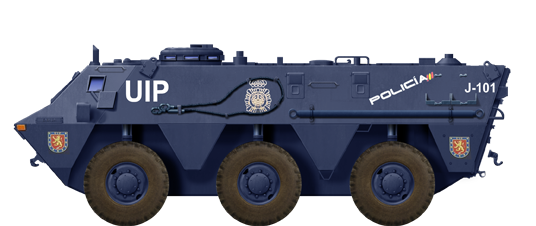
Police Vehicle
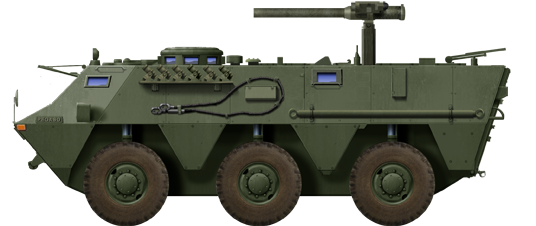
BMR C/C TOW tank hunter
BMR EOD in Kosovo, 2001 (To come)

BMR-PM-811 mortar carrier
BRM AMB (To come)
BRM ARV (To come)
Gallery

Original Pegaso BMR-600, serie 2. Note the absence of riveted panels, raised roof side armour and raised pannier aft.

Spanish Army BMR VCZ combat engineering vehicle in Iraq, 2004

M1 converted from a serie 1 in manoeuvers. Note also the raised pannier "stuffed", acting as addon back protection.

M1 crossing a pontoon bridge in a NATO exercize. Note the access hatch to the internal winch in the undernose.

M1 in Afhganistan. The add-on spaced armour plates transitioning to the old hull can be seen where the two jerrycans are stored.

BMR M1 PC, the command version in parade, which shares the same raised compartment with the ambulance, EW and Communication vehicles

VMR M1 in Afghanistan. Note all the gear strapped and stored on the vehicle, rear pannier and side pannier full.

ENASA VTC M1 Infantry Fighting Vehicle to compare.
Sources/Read More
Links
defensa.comcold war spanish tanks - BMR 600 part. Tank Encyclopedia
armedforces.eu
globalsecurity.org
militarytoday.com/apc/bmr600
army-guide.com/
en.wikipedia.org/
militaryfactory.com
artemilitarynaval.es/
armyrecognition.com
thetankmaker.blogspot.com
tanknutdave.com/
armedforces.co.uk
caballipedia.es
portierramaryaire.com
en.wikipedia.org
Video of a captured Saudi BMR

Cold War Tanks


































Cold war tanks posters

Cold War Main Battle Tanks

Cold War Soviet Army
Museums, Movies, Books & Games
The Tanks and Armor in pop culture
Tanks and armored vehicles in general are only really grasped when seen first person: The mass, the scale, it's all there. Explore also the way tanks were covered in the movie industry, in books and in video games.Movies:
Best tanks movie on warhistoryonline.com
On imdb.com
On bestsimilar.com/
miltours.com
liveabout.com/
watchmojo.com
Video Games:
pcgamesn.com
historyhit.com
levvvel.com
vg247.com/best-tank-games
mmobomb.com/
alienwarearena.com
